CHRYSLER SEBRING COUPE 2004 2.G Manual PDF
Manufacturer: CHRYSLER, Model Year: 2004, Model line: SEBRING COUPE, Model: CHRYSLER SEBRING COUPE 2004 2.GPages: 382, PDF Size: 2.23 MB
Page 71 of 382
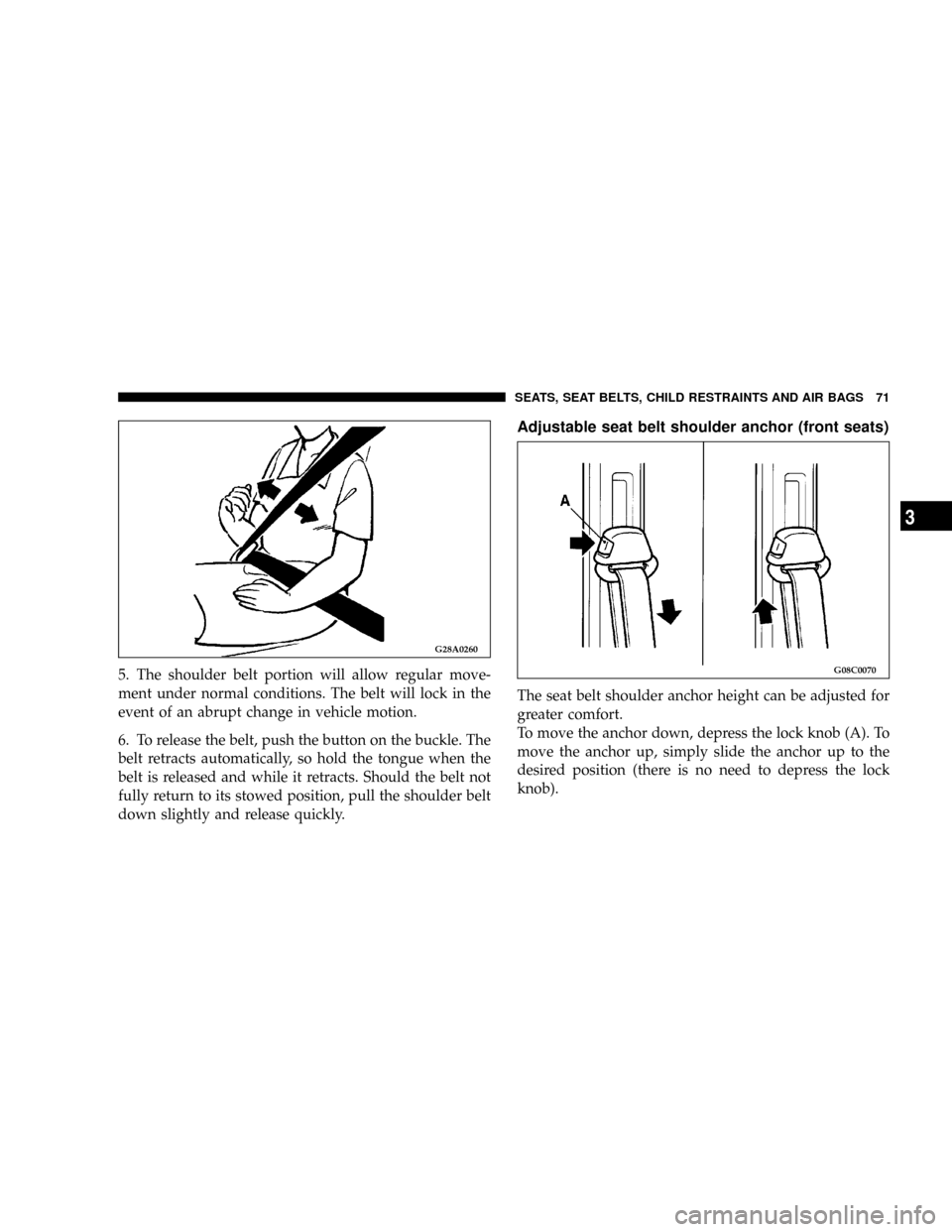
5. The shoulder belt portion will allow regular move-
ment under normal conditions. The belt will lock in the
event of an abrupt change in vehicle motion.
6. To release the belt, push the button on the buckle. The
belt retracts automatically, so hold the tongue when the
belt is released and while it retracts. Should the belt not
fully return to its stowed position, pull the shoulder belt
down slightly and release quickly.
Adjustable seat belt shoulder anchor (front seats)
The seat belt shoulder anchor height can be adjusted for
greater comfort.
To move the anchor down, depress the lock knob (A). To
move the anchor up, simply slide the anchor up to the
desired position (there is no need to depress the lock
knob).
G28A0260
G08C0070
SEATS, SEAT BELTS, CHILD RESTRAINTS AND AIR BAGS 71
3
Page 72 of 382
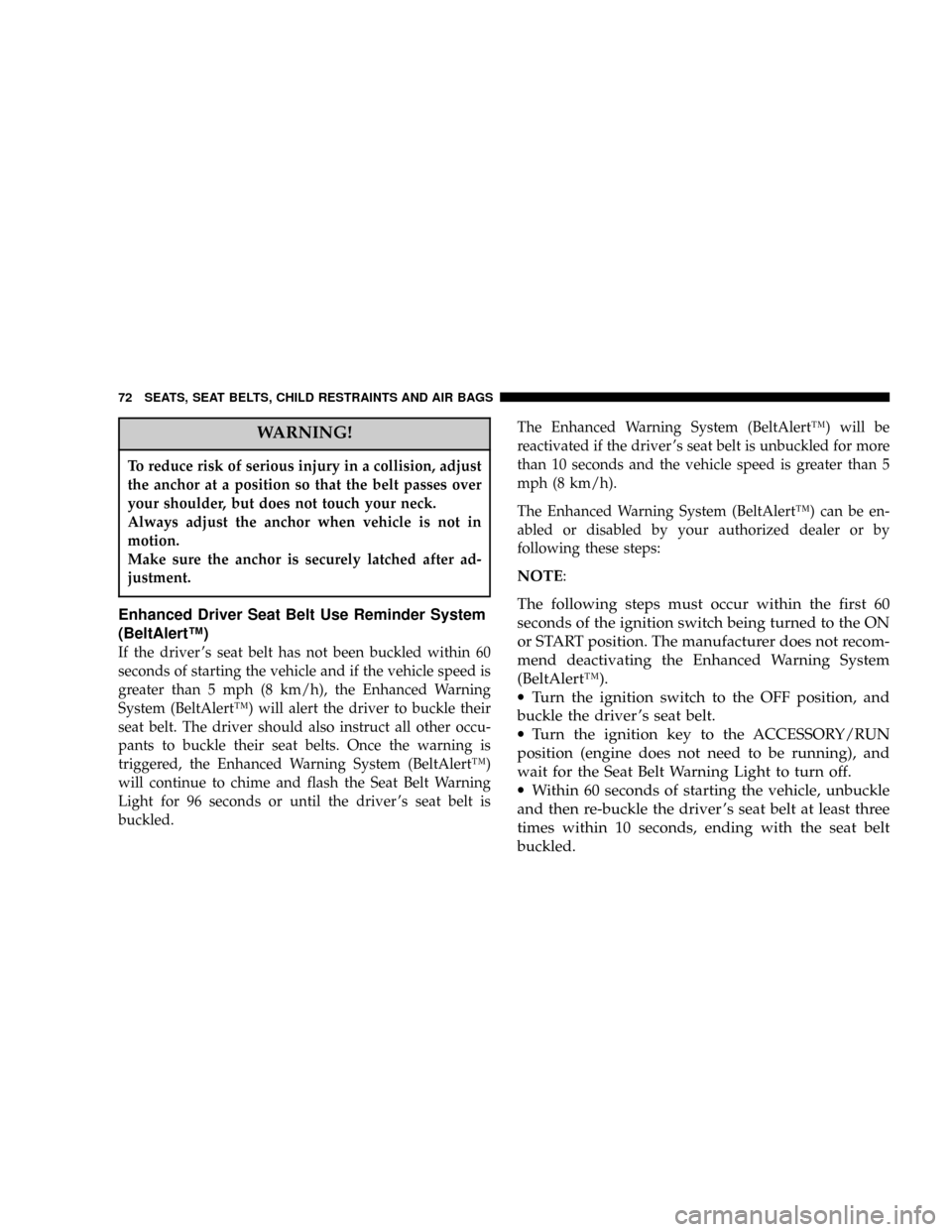
WARNING!
To reduce risk of serious injury in a collision, adjust
the anchor at a position so that the belt passes over
your shoulder, but does not touch your neck.
Always adjust the anchor when vehicle is not in
motion.
Make sure the anchor is securely latched after ad-
justment.
Enhanced Driver Seat Belt Use Reminder System
(BeltAlertŸ)
If the driver 's seat belt has not been buckled within 60
seconds of starting the vehicle and if the vehicle speed is
greater than 5 mph (8 km/h), the Enhanced Warning
System (BeltAlertŸ) will alert the driver to buckle their
seat belt. The driver should also instruct all other occu-
pants to buckle their seat belts. Once the warning is
triggered, the Enhanced Warning System (BeltAlertŸ)
will continue to chime and flash the Seat Belt Warning
Light for 96 seconds or until the driver 's seat belt is
buckled.The Enhanced Warning System (BeltAlertŸ) will be
reactivated if the driver 's seat belt is unbuckled for more
than 10 seconds and the vehicle speed is greater than 5
mph (8 km/h).
The Enhanced Warning System (BeltAlertŸ) can be en-
abled or disabled by your authorized dealer or by
following these steps:
NOTE:
The following steps must occur within the first 60
seconds of the ignition switch being turned to the ON
or START position. The manufacturer does not recom-
mend deactivating the Enhanced Warning System
(BeltAlertŸ).
·Turn the ignition switch to the OFF position, and
buckle the driver 's seat belt.
·Turn the ignition key to the ACCESSORY/RUN
position (engine does not need to be running), and
wait for the Seat Belt Warning Light to turn off.
·Within 60 seconds of starting the vehicle, unbuckle
and then re-buckle the driver 's seat belt at least three
times within 10 seconds, ending with the seat belt
buckled.
72 SEATS, SEAT BELTS, CHILD RESTRAINTS AND AIR BAGS
Page 73 of 382
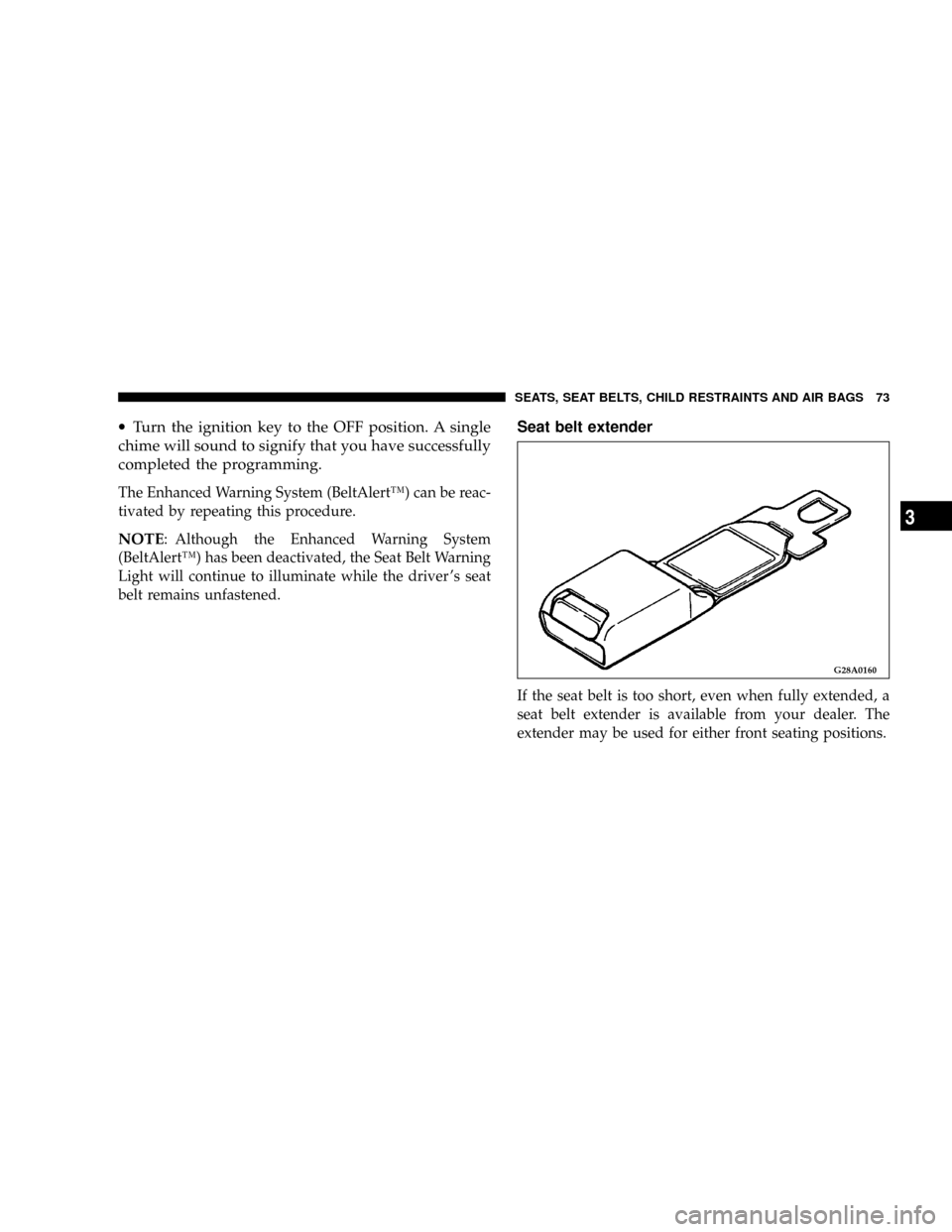
·Turn the ignition key to the OFF position. A single
chime will sound to signify that you have successfully
completed the programming.
The Enhanced Warning System (BeltAlertŸ) can be reac-
tivated by repeating this procedure.
NOTE: Although the Enhanced Warning System
(BeltAlertŸ) has been deactivated, the Seat Belt Warning
Light will continue to illuminate while the driver 's seat
belt remains unfastened.
Seat belt extender
If the seat belt is too short, even when fully extended, a
seat belt extender is available from your dealer. The
extender may be used for either front seating positions.
G28A0160
SEATS, SEAT BELTS, CHILD RESTRAINTS AND AIR BAGS 73
3
Page 74 of 382
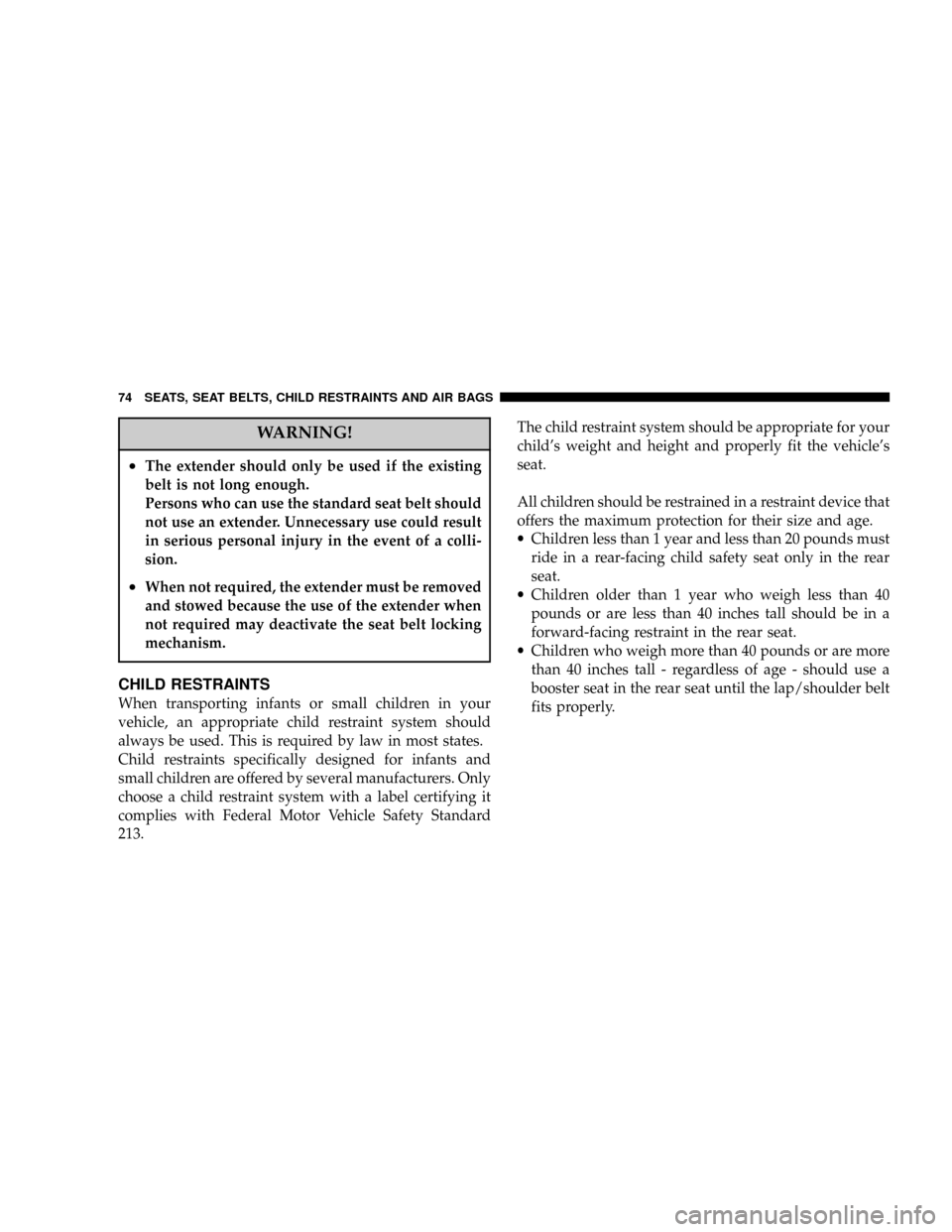
WARNING!
²The extender should only be used if the existing
belt is not long enough.
Persons who can use the standard seat belt should
not use an extender. Unnecessary use could result
in serious personal injury in the event of a colli-
sion.
²When not required, the extender must be removed
and stowed because the use of the extender when
not required may deactivate the seat belt locking
mechanism.
CHILD RESTRAINTS
When transporting infants or small children in your
vehicle, an appropriate child restraint system should
always be used. This is required by law in most states.
Child restraints specifically designed for infants and
small children are offered by several manufacturers. Only
choose a child restraint system with a label certifying it
complies with Federal Motor Vehicle Safety Standard
213.The child restraint system should be appropriate for your
child's weight and height and properly fit the vehicle's
seat.
All children should be restrained in a restraint device that
offers the maximum protection for their size and age.
·Children less than 1 year and less than 20 pounds must
ride in a rear-facing child safety seat only in the rear
seat.
·Children older than 1 year who weigh less than 40
pounds or are less than 40 inches tall should be in a
forward-facing restraint in the rear seat.
·Children who weigh more than 40 pounds or are more
than 40 inches tall - regardless of age - should use a
booster seat in the rear seat until the lap/shoulder belt
fits properly.
74 SEATS, SEAT BELTS, CHILD RESTRAINTS AND AIR BAGS
Page 75 of 382
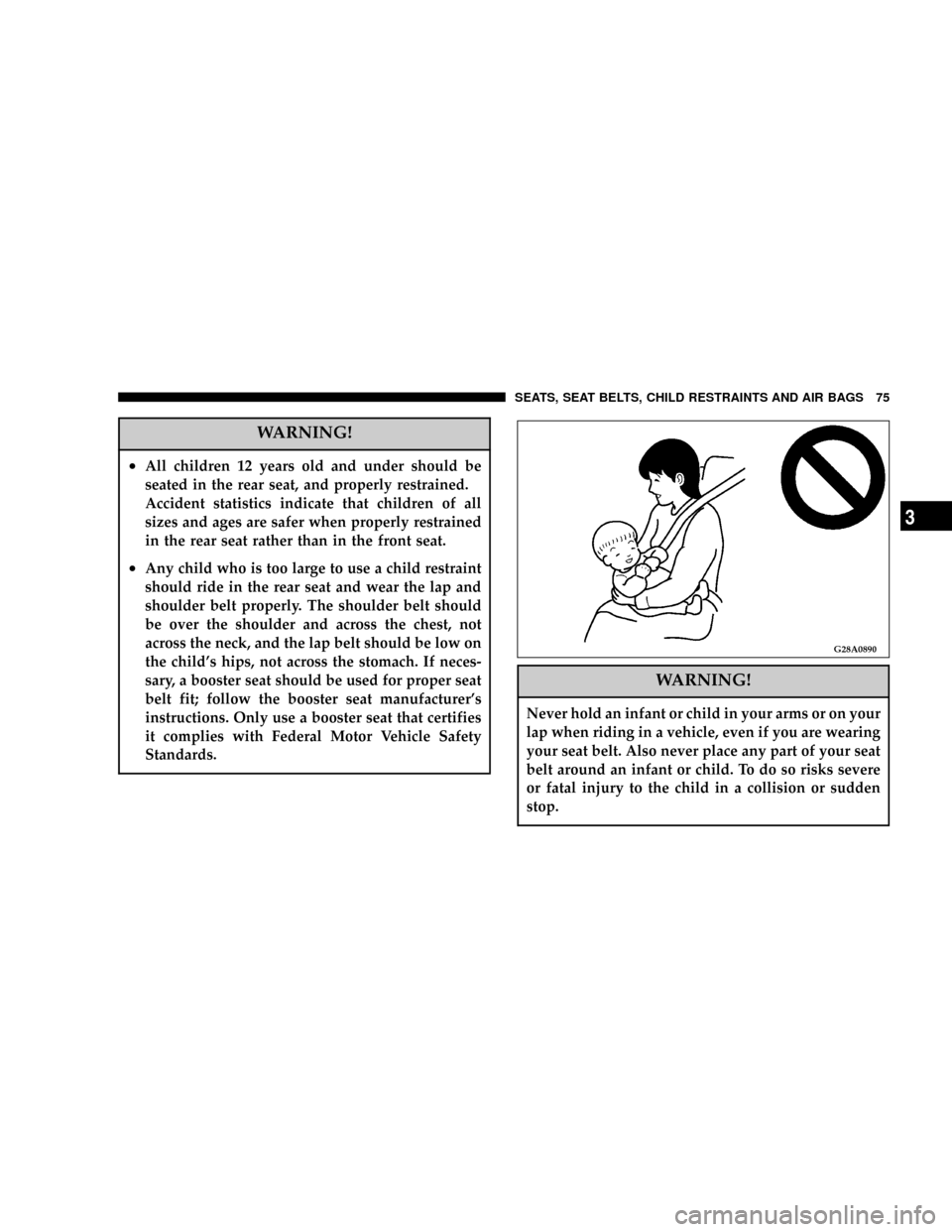
WARNING!
²All children 12 years old and under should be
seated in the rear seat, and properly restrained.
Accident statistics indicate that children of all
sizes and ages are safer when properly restrained
in the rear seat rather than in the front seat.
²Any child who is too large to use a child restraint
should ride in the rear seat and wear the lap and
shoulder belt properly. The shoulder belt should
be over the shoulder and across the chest, not
across the neck, and the lap belt should be low on
the child's hips, not across the stomach. If neces-
sary, a booster seat should be used for proper seat
belt fit; follow the booster seat manufacturer's
instructions. Only use a booster seat that certifies
it complies with Federal Motor Vehicle Safety
Standards.
WARNING!
Never hold an infant or child in your arms or on your
lap when riding in a vehicle, even if you are wearing
your seat belt. Also never place any part of your seat
belt around an infant or child. To do so risks severe
or fatal injury to the child in a collision or sudden
stop.
G28A0890
SEATS, SEAT BELTS, CHILD RESTRAINTS AND AIR BAGS 75
3
Page 76 of 382
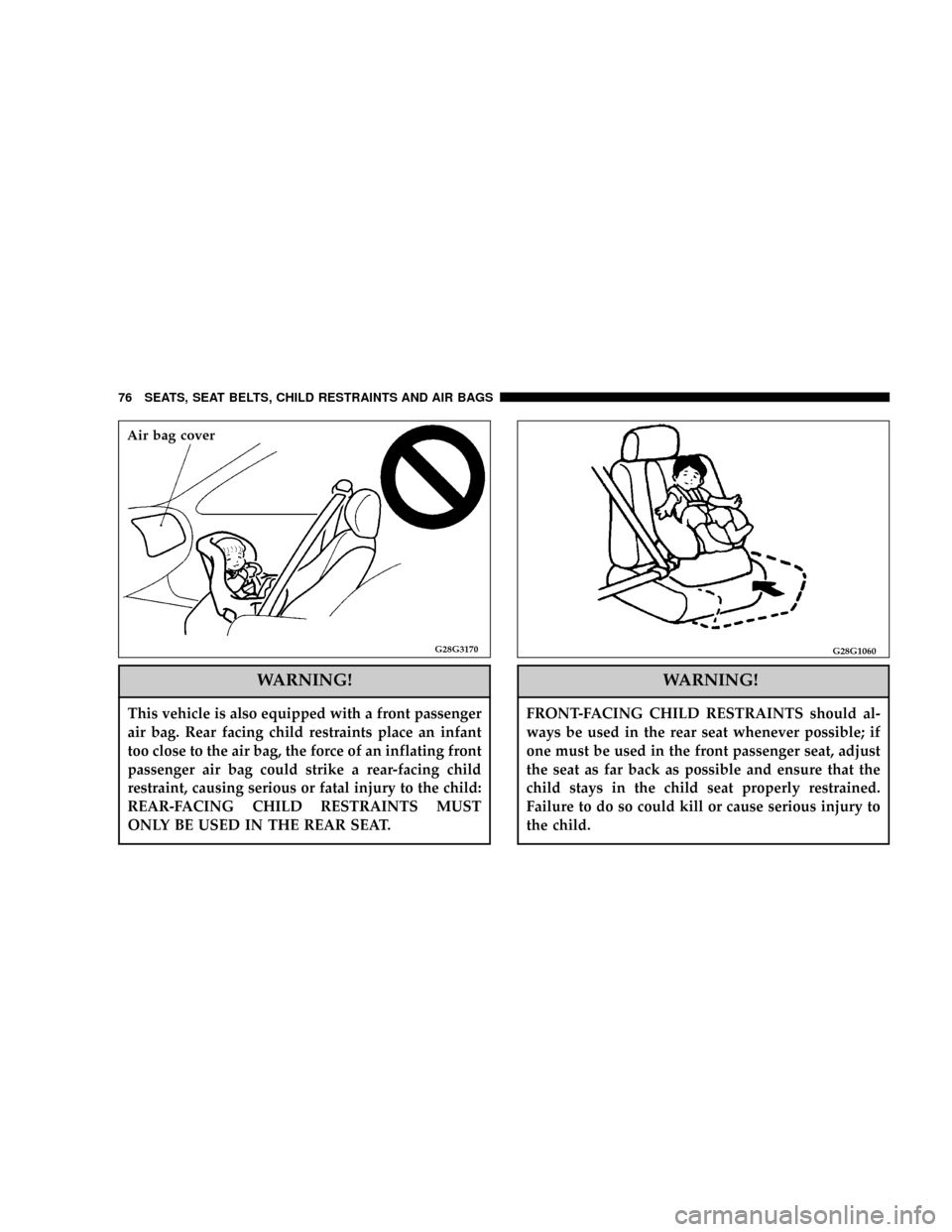
WARNING!
This vehicle is also equipped with a front passenger
air bag. Rear facing child restraints place an infant
too close to the air bag, the force of an inflating front
passenger air bag could strike a rear-facing child
restraint, causing serious or fatal injury to the child:
REAR-FACING CHILD RESTRAINTS MUST
ONLY BE USED IN THE REAR SEAT.
WARNING!
FRONT-FACING CHILD RESTRAINTS should al-
ways be used in the rear seat whenever possible; if
one must be used in the front passenger seat, adjust
the seat as far back as possible and ensure that the
child stays in the child seat properly restrained.
Failure to do so could kill or cause serious injury to
the child.
G28G3170
Air bag cover
G28G1060
76 SEATS, SEAT BELTS, CHILD RESTRAINTS AND AIR BAGS
Page 77 of 382
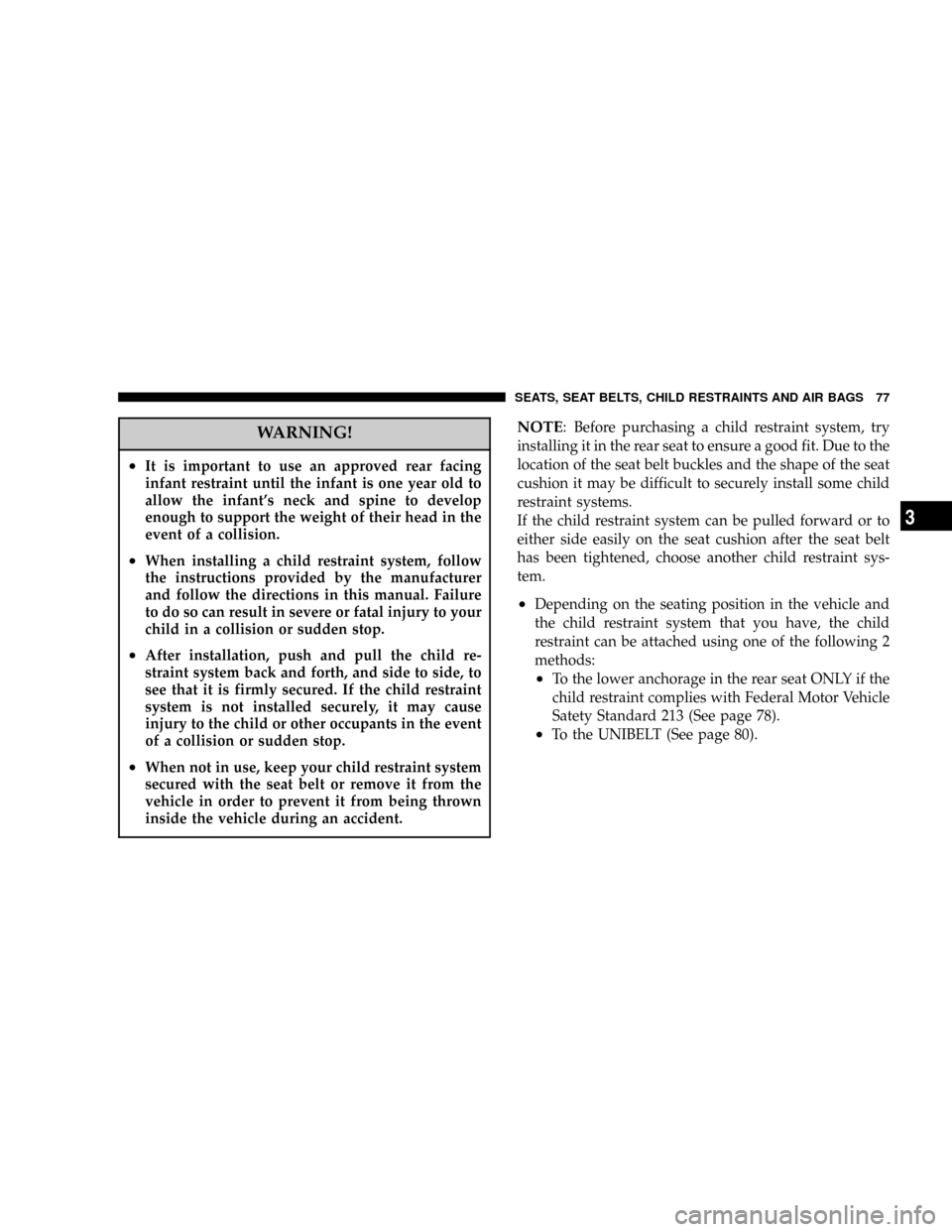
WARNING!
²It is important to use an approved rear facing
infant restraint until the infant is one year old to
allow the infant's neck and spine to develop
enough to support the weight of their head in the
event of a collision.
²When installing a child restraint system, follow
the instructions provided by the manufacturer
and follow the directions in this manual. Failure
to do so can result in severe or fatal injury to your
child in a collision or sudden stop.
²After installation, push and pull the child re-
straint system back and forth, and side to side, to
see that it is firmly secured. If the child restraint
system is not installed securely, it may cause
injury to the child or other occupants in the event
of a collision or sudden stop.
²When not in use, keep your child restraint system
secured with the seat belt or remove it from the
vehicle in order to prevent it from being thrown
inside the vehicle during an accident.
NOTE: Before purchasing a child restraint system, try
installing it in the rear seat to ensure a good fit. Due to the
location of the seat belt buckles and the shape of the seat
cushion it may be difficult to securely install some child
restraint systems.
If the child restraint system can be pulled forward or to
either side easily on the seat cushion after the seat belt
has been tightened, choose another child restraint sys-
tem.
²Depending on the seating position in the vehicle and
the child restraint system that you have, the child
restraint can be attached using one of the following 2
methods:
²To the lower anchorage in the rear seat ONLY if the
child restraint complies with Federal Motor Vehicle
Satety Standard 213 (See page 78).
²To the UNIBELT (See page 80).
SEATS, SEAT BELTS, CHILD RESTRAINTS AND AIR BAGS 77
3
Page 78 of 382
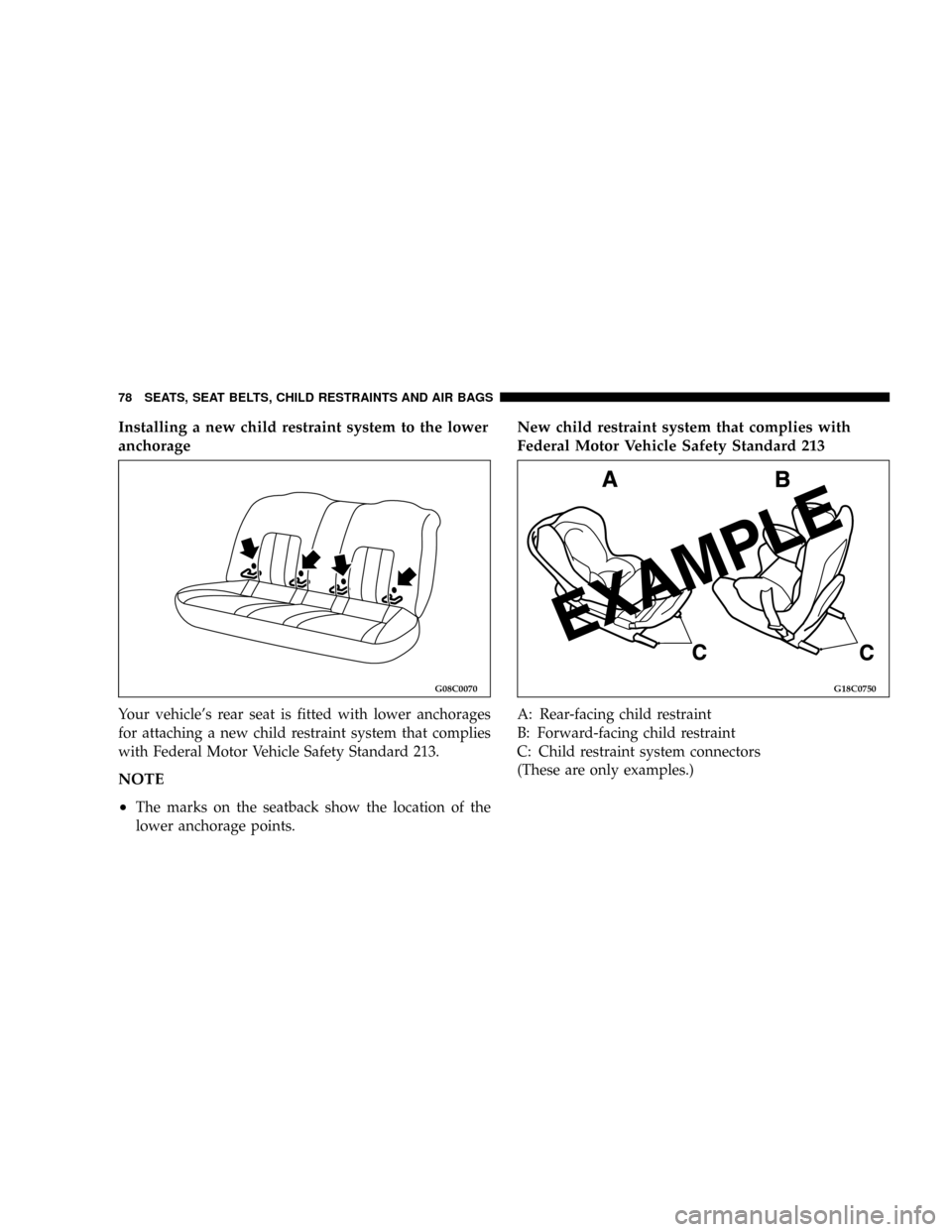
Installing a new child restraint system to the lower
anchorage
Your vehicle's rear seat is fitted with lower anchorages
for attaching a new child restraint system that complies
with Federal Motor Vehicle Safety Standard 213.
NOTE
²
The marks on the seatback show the location of the
lower anchorage points.
New child restraint system that complies with
Federal Motor Vehicle Safety Standard 213
A: Rear-facing child restraint
B: Forward-facing child restraint
C: Child restraint system connectors
(These are only examples.)
G08C0070G18C0750
78 SEATS, SEAT BELTS, CHILD RESTRAINTS AND AIR BAGS
Page 79 of 382
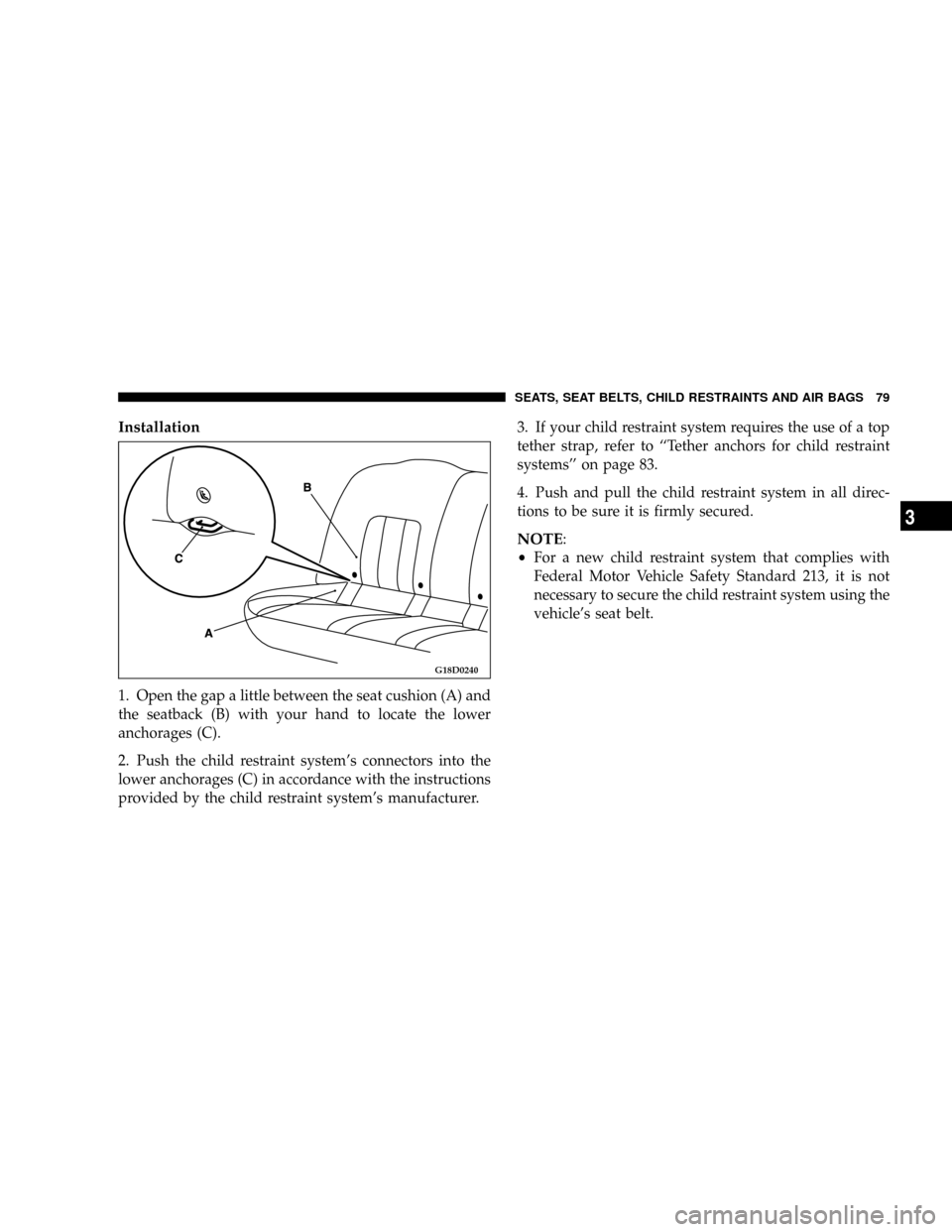
Installation
1. Open the gap a little between the seat cushion (A) and
the seatback (B) with your hand to locate the lower
anchorages (C).
2. Push the child restraint system's connectors into the
lower anchorages (C) in accordance with the instructions
provided by the child restraint system's manufacturer.3. If your child restraint system requires the use of a top
tether strap, refer to ``Tether anchors for child restraint
systems'' on page 83.
4. Push and pull the child restraint system in all direc-
tions to be sure it is firmly secured.
NOTE:
²For a new child restraint system that complies with
Federal Motor Vehicle Safety Standard 213, it is not
necessary to secure the child restraint system using the
vehicle's seat belt.
G18D0240
SEATS, SEAT BELTS, CHILD RESTRAINTS AND AIR BAGS 79
3
Page 80 of 382
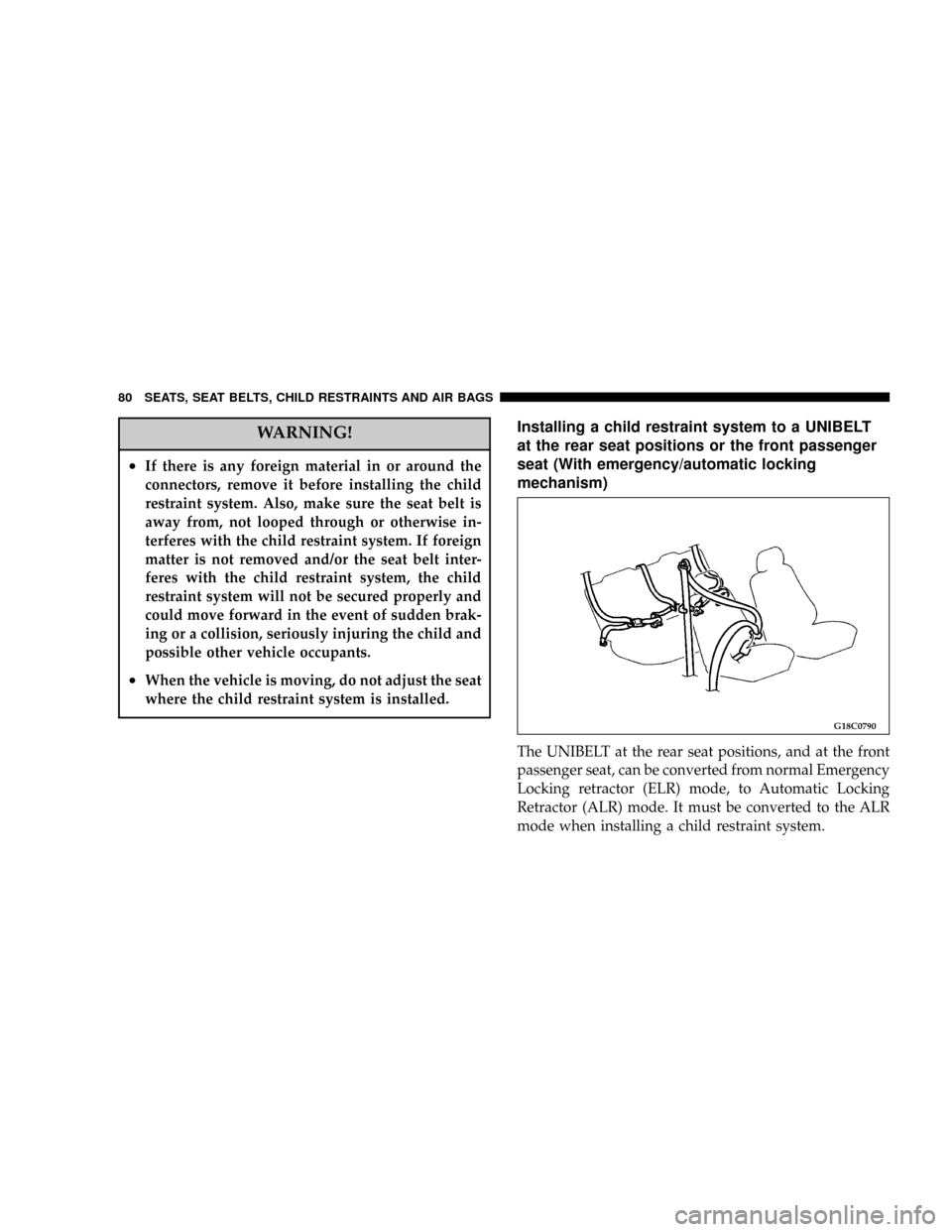
WARNING!
²If there is any foreign material in or around the
connectors, remove it before installing the child
restraint system. Also, make sure the seat belt is
away from, not looped through or otherwise in-
terferes with the child restraint system. If foreign
matter is not removed and/or the seat belt inter-
feres with the child restraint system, the child
restraint system will not be secured properly and
could move forward in the event of sudden brak-
ing or a collision, seriously injuring the child and
possible other vehicle occupants.
²When the vehicle is moving, do not adjust the seat
where the child restraint system is installed.
Installing a child restraint system to a UNIBELT
at the rear seat positions or the front passenger
seat (With emergency/automatic locking
mechanism)
The UNIBELT at the rear seat positions, and at the front
passenger seat, can be converted from normal Emergency
Locking retractor (ELR) mode, to Automatic Locking
Retractor (ALR) mode. It must be converted to the ALR
mode when installing a child restraint system.
G18C0790
80 SEATS, SEAT BELTS, CHILD RESTRAINTS AND AIR BAGS